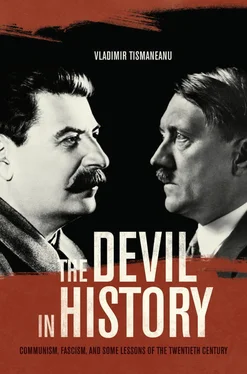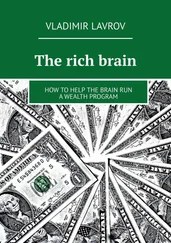The primary form of charisma, in the Soviet case, was that of the party as scientific socialism incarnate, the eschatological agent that stressed “the gap between the proletariat ‘in itself’ and the proletariat ‘for itself’ and the creation of an agent charged with closing this gap.” 29Even Stalin’s legitimacy, at the peak of the cult of personality, “in the eyes of his fellow party leaders rested in what they saw as his role of guarantor of their collective power of the state.” 30As in Mussolini’s case, 31Lenin remained the founder of Bolshevism, the head of the Soviet state (first workers’ state), and the leader of the Soviet peoples. Under Stalinism, “the fact that the party existed as a continuous, integrated hierarchy, which was institutionally and ideologically embedded in the system, meant that it always existed as a resource for correcting and reining in the regime’s most extreme policies. The institutional continuity of the party provided the basis for self-containment.” 32Such a specific alignment allowed for successive Leninist reinventions and stagnations in both the Soviet Union and Eastern Europe. One possible explanation for the immensely explosive impact of Nikita Khrushchev’s “Secret Speech” (February 1956) was, besides the classical remark about the acceptance of fallibility in the implementation of the party line at the highest level of power, that the revealed crimes were against the party. The Stalin myth irreversibly subverted the party’s “charismatic impersonalism” (in the words of Ken Jowitt). 33The bottom line is, for the moment, that both Fascism (in its Italian avatar) and Leninism had the possibility of charismatic regeneration built in regardless of the leadership’s persona. What counted for true believers was the salvific promise incarnated in the party—the source of freedom through successful experimentation with history. However, in the Italian case, such a revival of the party after Mussolini’s demise proved impossible because of the disastrous situation in which the country found itself as a result of the National Fascist Party’s shockingly incompetent administration of the war effort. Historian R. J. B. Bosworth noticed that even during the Salo Republic, “the new regime carefully avoided the word ‘Fascist,’ opting instead for ‘social’ as a signal of its revolutionary commitment to a ‘new order’ at home and abroad.” The new República Sociale Italiana can be perceived as a desperate but doomed attempt to revive the heroic mission of Fascism in Italy. 34
There was a major distinction between Communism and Fascism in identifying the place of charisma: Leninists worshipped the party (and the leader as the guarantor of the correct party line), whereas Fascists lionized the magnetic personality of a presumably infallible leader. This explains the enduring fascination with Communism among individuals who continued to believe in its promise of a new society and of social, economic, cultural, and political transformation, even after Khrushchev exposed Stalin’s abominable crimes. A lingering sentiment that there was after all something moral in Bolshevik utopianism, plus the exploitation of anti-Fascist emotions, led to a persistent failure to acknowledge the basic fact that, from its inception, Sovietism was a criminal system.
I vividly remember a conference in New York in October 1987, when statements by two dissidents (the Russian Eduard Kuznetsov and the Romanian Dorin Tudoran) about Communism as a “criminal civilization” provoked an angry response from Mihailo Markovic, the Yugoslavian critical Marxist who in the late 1990s became the main ideologue of the Milosevic regime. Simply put, to document and condemn the bestiality of the Nazis was acceptable, but to focus on analogous atrocities perpetrated by the radical Left appeared as primitive anti-Communism. Albert Camus once summarized the moral perplexity provoked by such a consistent barrage of ideologically motivated prejudice: “When I demand justice, I seem to be asking for hate.” 35The revolutions of 1989 and the collapse of the Soviet Union in 1991 changed the situation. The Soviet bloc’s efforts to create the City of God here and now, the search for the perfect society, turned out to be an abysmal disaster. The record sheet of these regimes was one of absolute failure, economically, politically, and morally. It is high time for their victims to be remembered. Norman Naimark has formulated a priority for historical scholarship: “In the final analysis, both totalitarian states—Nazi Germany and Stalinist Russia—were perpetrators of genocide, the ‘crime of crimes.’ In spite of the fall of the Soviet Union and the attendant greater access to information, we know much more about the Nazi atrocities than we do about the Soviet ones, and about those who initiated, organized, and carried them out. The crucial issue of intentionality and criminal culpability in the Soviet case can only be settled definitively with full access to Russian archives and to those responsible, who still survive.” 36Such conceptualization should be extended to the period of “High Stalinism” in China, Albania, Romania, Hungary, and Bulgaria (1949-1953), and even the genocidal terrorism of the Pol Pot regime in Cambodia. In each of these cases one can see how the persistence of the will to sacrifice entire sections of society on the altar of the political myth materialized in a large-scale commitment to violence. 37
The comparative evaluation and memory of Communism and Fascism were undeniably marked, mediated, and instrumentalized by the tradition of anti-Fascism in the West. At the root of this fundamental intellectual and public ethos lay a flawed and guilty interpretation of the Communist past. The latter was defined, on the one hand, by silence, partiality, or ignorance regarding the crimes and dictatorship of Leninist party-states, and on the other hand, by the difficulty of separating anti-Fascism from the imperialist propaganda of the Soviet Union during the twentieth century (or China, and their various satellites). The case of the Spanish Civil War remains paradigmatic for the entire history of anti-Fascism. François Furet gave an excellent characterization of the grievous misrepresentation that engendered this tradition: “Communist antifascism had two faces, neither of which happened to be democratic; the first face that of solidarity, which had ennobled so many soldiers, perpetually concealed the pursuit of power and the confiscation of liberty.” Anti-Fascism functioned for most of its existence on the principle that cohesion had to be defended at all costs, even if this meant, to paraphrase Francis Ponge, taking the party out of things (the original coinage is “le parti pris des choses”). In Furet’s words, “In the hour of the Great Terror, Bolshevism reinvented itself as liberty by virtue of a negation.” 38
Subsequently, anti-Fascism was put in the situation of always turning out to be a mere rhetoric of democracy and freedom. It harbored “existential untruths” (to use Diner’s term), which it consistently failed to address because of its unflinching dedication to the Communist (i.e., Soviet) core ideology. Anti-Fascism therefore acquired a split personality: “It encompassed the totalitarian satraps of Eastern Europe as well as the political cosmos of the Western European Left from 1945 well into the 1970s.” 39Its proponents (and nowadays its survivors) adopted a hegemonic pretense to socialist utopia’s innocence in utter disregard of the criminality of the utopia in power. This anti-Fascist monopoly over the past “afflicted the very past itself.” 40
The anti-Fascist promise failed because of its umbilical connection to the Moscow center. It is difficult, therefore, to agree with historian Geoff Eley, who stated that the 1943-47 moment of anti-Fascist unity lost out because of “the sharpening tensions between the Soviet Union and United States…. [A]nd as Stalin hauled the communist parties back to a language of soviets and proletarian dictatorship, this sanctifying of parliamentarianism once again became a key marker of divisions on the left.” 41It failed because of the true nature of the Communist parties and of their leader, Stalin’s Communist Party (CPSU). It failed because it accepted the same contract of silence, the one it endorsed during the Great Terror, regarding the Zhdanovist offensive and the already sweeping Sovietization of some Eastern European countries (for example, the extermination camps and mass executions in Bulgaria between 1944 and 1947). 42Zhdanovism should not be reduced to simply meaning the “two-camp theory” spelled out by Stalin’s first lieutenant in September 1947 at the founding conference of the Information Bureau of the Communist and Workers’ Parties (Cominform). 43When referring to the times of Zhdanov (zhdanovshchina) , we think of the debate around official philosopher Georgi Aleksandrov’s History of West European Philosophy and the condemnation of Anna Akhmatova (slandered as driven by “a sex-crazed mystic longing for Catherine’s good old days”) and Mikhail Zoshchenko. 44These key moments of the immediate aftermath of the Second World War triggered in the USSR (and, by default, in the Soviet satellite countries) a new wave of terroristic frenzy under the guise of anticosmopolitanism and ideological remobilization. These domestic dynamics preceded the inception of the Cold War. Also, one should not forget the execution and imprisonment of millions of Soviet citizens scattered across Hitler’s Reich (POWs, individuals used as forced labor by the Nazis, or concentration camp inmates) upon their forced return by the Allies to the USSR. Postwar Soviet Union was the antithesis of freedom and democracy; it was indeed “a world built on slavery.” 45After surveying the existent data, Timothy Snyder concludes that “there were never more Soviet citizens in the Gulag than in the years after the war; indeed, the number of Soviet citizens in the camps and special settlements increased every year from 1945 until Stalin’s death.” 46With such a system spearheading the anti-Fascist movement, there was no chance for any renewal of the Left. 47But after the defeat of Hitler, anti-Fascism was entrenched as politicized will, feeding on its own self-righteousness, thrusting blindly forward in a frenzied activism. It thus only worsened a pre-existing fascination with Stalin’s “Great Experiment.” In this context, as Sydney Hook remarked, “Intellectual integrity became the first victim of political enthusiasm.” 48
Читать дальше












